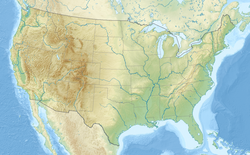The Hinsdale Formation is a geologic formation exposed in southwestern Colorado and northern New Mexico.[2] It has a radiometric age of 4.4 to 26.8 million years, corresponding to the Neogene period.[3]
| Hinsdale Formation | |
|---|---|
| Stratigraphic range: Neogene | |
 Hinsdale Formation at its type locality in Colorado (Devils Lake, Powderhorn Wilderness) | |
| Type | Formation |
| Overlies | Los Pinos Formation[1] |
| Thickness | 1,200 ft (370 m) |
| Lithology | |
| Primary | Basalt, andesite, rhyolite |
| Location | |
| Coordinates | 37°47′13″N 107°19′08″W / 37.787°N 107.319°W |
| Region | Colorado New Mexico |
| Country | United States |
| Type section | |
| Named for | Hinsdale County, Colorado |
| Named by | Charles Whitman Cross |
| Year defined | 1911 |
Description
editThe Hinsdale Formation is a bimodal volcanic formation, containing silica-poor olivine basalt and high-silica rhyolite with only small quantities of volcanic rock of intermediate composition.[4] The sequence reflects assimilation and fractional crystallization (AFC) of a primitive basalt magma.[5] Total thickness is in excess of 1,200 feet (370 m).[2]
The formation is the youngest volcanic formation of the San Juan volcanic field, and is separated from older units by a significant erosional surface.[2] Radiometric ages range from 4.4 to 26.8 million years.[3] The formation once formed an extensive thin veneer over the San Juan volcanic field before itself being eroded.[5]
The change to bimodal association coincided with the transition from Laramide compression to Rio Grande rift extension, a pattern seen elsewhere in the western United States.[5]
Economic geology
editThe rich mineralization of the San Juan Volcanic Field has been attributed to early intrusions of the Hinsdale Formation.[6]
History of investigation
editThe formation was first named the Hinsdale Volcanic Series by Charles Whitman Cross in 1911 for exposures in Hinsdale County, Colorado.[2] Larsen redefined the unit as the Hinsdale Formation and included the Los Pinos Member.[7] Barker removed the Los Pinos as its own formation in 1958.[8]
Footnotes
editReferences
edit- Barker, Fred (1958). "Precambrian and Tertiary geology of Las Tablas quadrangle, New Mexico". New Mexico Bureau of Mines and Mineral Resources Bulletin. 45. Retrieved 28 June 2020.
- Bethke, P. M.; Barton, P. B.; Lanphere, M. A.; Steven, T. A. (1 October 1976). "Environment of ore deposition in the Creede mining district, San Juan Mountains, Colorado; II, Age of mineralization". Economic Geology. 71 (6): 1006–1011. Bibcode:1976EcGeo..71.1006B. doi:10.2113/gsecongeo.71.6.1006.
- Cross, Whitman (1911). "Geology of area near Lake City, Colorado". In Irving, J.D.; Bancroft, Howland (eds.). Geology and ore deposits near Lake City, Colorado: U.S. Geological Survey Bulletin 478. pp. 18–32. Retrieved 31 August 2020.
- Cross, Whitman; Larsen, E.S. (1935). "A brief review of the geology of the San Juan region of southwestern Colorado". U.S. Geological Survey Bulletin. 843. Retrieved 31 August 2020.
- Lipman, Peter W.; Steven, Thomas A.; Mehnert, Harald H. (1970). "Volcanic History of the San Juan Mountains, Colorado, as Indicated by Potassium–Argon Dating". Geological Society of America Bulletin. 81 (8): 2329. Bibcode:1970GSAB...81.2329L. doi:10.1130/0016-7606(1970)81[2329:VHOTSJ]2.0.CO;2.
- Manley, Kim (1 December 1981). "Redefinition and description of the Los Pinos Formation of north-central New Mexico". GSA Bulletin. 92 (12): 984–989. Bibcode:1981GSAB...92..984M. doi:10.1130/0016-7606(1981)92<984:RADOTL>2.0.CO;2.
- Parker, D.F.; Ghosh, A.; Price, C.W.; Rinard, B.D.; Cullers, R.L.; Ren, M. (January 2005). "Origin of rhyolite by crustal melting and the nature of parental magmas in the Oligocene Conejos Formation, San Juan Mountains, Colorado, USA". Journal of Volcanology and Geothermal Research. 139 (3–4): 185–210. Bibcode:2005JVGR..139..185P. doi:10.1016/j.jvolgeores.2004.08.015.
- Thompson, Ren A.; Machette, Michael N. (1989). "Geologic Map of the San Luis Hills Area, Conejos and Costilla Counties, Colorado" (PDF). U.S. Geological Survey Miscellaneous Investigations Series Map. I-1906. doi:10.3133/i1906. Retrieved 31 August 2020.

